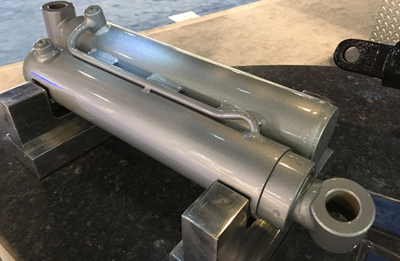Piggy-back cylinders, as the name implies, are two opposing hydraulic cylinders mounted with the bodies on top of each other. Taking advantage of this configuration enables a longer stroke from a relatively short overall length. They’re somewhat similar to familiar telescoping cylinders, where several cylinder stages are built inside of one another, and the unit features relatively short retracted length but long extended length. But when only two stages are required, a piggy-back cylinder can be a simpler and more-economical alternative.

Piggy-back cylinders from Texas Hydraulics, Temple, Tex., are made of two rod cylinders with the barrels welded or bolted together. They’re designed for applications with limited mounting space that require a long extended length and a short retraction length. They provide consistent force and speed, and they’re suited for low and high-pressure applications.
Usually, the two cylinders have the same bore and stroke, and only one hydraulic line each is needed for extension and one line for retraction. This simplifies plumbing and limits potential leak points. Units with the same bore sizes also have interchangeable seals.
Optional features include rod or tube porting, integrated valving and built-in cushions. Piggy-back cylinders can also be designed for sequencing and multiple stopping points. For instance, by specifying a different stroke for each cylinder, and adding hydraulic lines for each, four different positions can be controlled: when both cylinders are retracted, when only the first cylinder extends, when only the second extends, and when both cylinders extend.
The versatile cylinders are suited for many applications across various industries. Examples include jack/outrigger extension, boom extension, wreckers and tow vehicles, truck-mounted cranes, chutes and dump applications.
Texas Hydraulics
www.texashydraulics.com


Very interesting indeed, but the title of the article is “The ins and outs of piggyback hydraulic cylinders”.
Looks like you forgot to spend few words about the outs.
Can anyone advise me regarding the use of opposing hydraulic cylinders performance. My question is: If I press downward with a 10 ton/in2 hydraulic press with one cylinder and press upwards with with another 15 ton/in2 hydraulic cylinder, would the pressure in between these two opposing cylinders be 25 tons? Assuming that in between these two opposing cylinders is a hollow space that each of the two cylinders enter from opposite sides and inside this space is 300 grams of Mn metal fines mixed with a resin binder.. when both cylinders are activated They press the Mn metal into a briquette.
Basically, is there a greater pressing effect by pushing from both ends (15 + 10 = 25 tons per square inch) or would the effect be the same as pushing 15 tons down onto the same material from one direction only against a fixed end.
Thank you